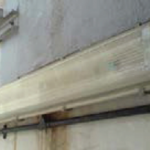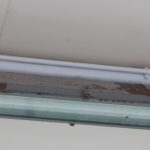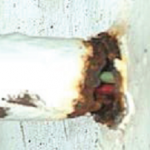|
Defects
|
Probable causes for the defect
|
Design for Maintainability (DfM) Guidelines
|
| Lamps blink, flicker, freq. blow off
|
- Voltage dip if cable between lamp and fused splitter is too long or a heavy motor without reduced voltage starter is in same supply line.
- Exhausted lamp life. Need replacement.
- No over current protection device (fuse / circuit breaker) provided.
|
Design
Construction
Maintenance
|
| Less light |
- Shadow casting by over-decorative luminaire.
- Lumen outputs of lamps are inadequate..
- Luminaire spacing is too high. Usually such mismatch occurs when the luminaire can not be shifted according to new interior layout
- Covered by dirt, dust, and grime. Poor maintenance or design of luminaire is prone to collect dust.
- Reduced lamp life with time – no regular replacement.
|
Design
Construction
Maintenance
|
| No light |
- Connection of lamp and corresponding switch is not proper. Lights controlled by 2, 3 or 4 way switch mainly suffers from such coordination issues.
- Blown lamp is not replaced.
- Metal halide lamps upon voltage drop take few minutes to restart.
|
Design
Construction
Maintenance
|
Faulty/compromised
artificial lighting and
control system
 Discoloured outdoor lighting cover  Damaged casing of outdoor light
 Corroded metal conduit
|
- Wear and tear with time.
- Exposure to direct weather condition.
|
Design
- Ensure that lighting design will improve energy and sustainability objectives of the building.
- Specify a centralised lighting control system that allows easy monitoring; or automate the system with a proper control strategy.
- Ensure that:
— the lighting control is readily accessible.
- — lamp efficacies and ballast energy performance should meet the latest Minimal Energy Performance Standard (MEPS).
— lighting power density is calculated for the building and, that it meets the lighting power budget in SS 530:2014 (see also ANSI/ASHRAE/IES Standard 90.1-2016).
— Calculate daylighting as per BS ISO 10916:2014
Construction
- Conform to the recommended illumination levels for office areas and task activities as per SS 514:2016 (see also CSA Z412-2000 (R2016), ISO 8995-1:2002/Cor 1:2005).
- Comply with specifications for luminaires, for general requirements and tests (SS IEC 60598-1:2016).
- Maintained illuminance depends on the maintenance characteristics of the lamp, the luminaire, the environment and maintenance programme (ISO 8995-1:2002/Cor 1:2005, SS 531-1:2006 (2013)).
- Display and ornamental lighting should be separately controlled.
Maintenance
- Conduct routine checking of adequate lighting levels and maintain adequate lux for appropriate activities in accordance to users’ needs and statutory guidelines (CSA Z412- 2000 (R2016), ISO 8995-1:2002/Cor 1:2005, SS 531-1:2006 (2013), SS 514:2016).
- Practice proper housekeeping by dusting off and cleaning lamp surfaces.
- Conduct regular inspection of light fittings and replace if burnt-out.
- Consider group re-lamping if lamps in the same batch are failing.
- Conduct routine check on transformers and drivers of luminaires.
- Check exterior lights for corrosion, torn cables, compromised watertight seals and discolouration; take remedial action where needed.
|
| Overheated / burnt ballast

Burnt ballast of blown lamp
|
- Flickering lamps.
- One of the paired lamps is removed or blown. If it is not replaced for a long time, ballasts get overheated from spark.
|
Design
Construction
Maintenance
|
| Noisy ballast |
- Loose fitting in the ballast causes vibration.
- Vibrations get amplified by large radiating surface of luminaires. Good quality products are tested to pass such design defects.
|
Design
Construction
Maintenance
|
References
[1]
Normative References/Standards Referred to for Air Handling Unit and Fan Coil Unit



